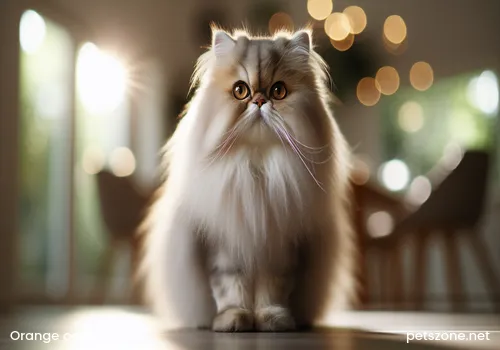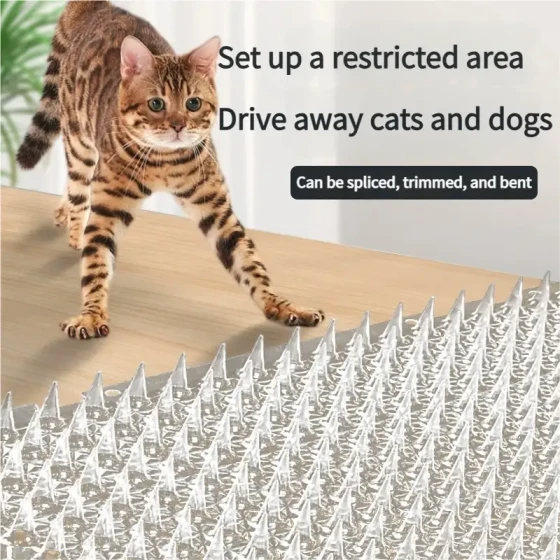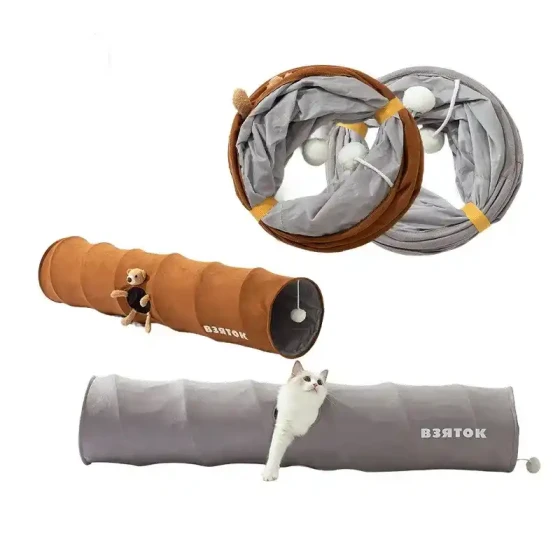Are Orange Cats Tabby Cats? Understand the Differences and Characteristics of the Two in One Article!
In the world of cats, both orange cats and tabby cats are highly loved types, but many people often confuse their relationship. This article will deeply analyze the definitions, differences, personality traits, and care recommendations of orange cats and tabby cats, helping cat lovers better understand these two types of cats.

Article Summary
Orange cats are not a specific breed but a general term for all cats with orange (yellow) fur, including various breeds with orange individuals. Tabby cats are a native Chinese cat breed with unique striped features. Orange tabby cats are a special type of orange cat but not all orange cats are tabby cats.
There are obvious differences in appearance and personality: tabby cats usually have clear stripes and a wild temperament, while orange cats are known for their gentle, clingy nature and "easy-to-gain-weight" physique. When choosing pets, personal preference and home environment should be considered. Tabby cats are more suitable for experienced cat owners, while orange cats are more friendly to beginners.
In terms of price, purebred Chinese tabby cats cost about 1000 yuan, while ordinary orange cats are mostly rural cats priced between 50-200 yuan. Regardless of the choice, understanding their characteristics helps build a better human-cat relationship.
Basic Definitions of Orange Cats and Tabby Cats
Orange cats are not a specific cat breed name but a collective term for all cats presenting orange (or yellow) fur color, similar to color classifications like "black cats" or "white cats." In felines, the orange fur gene is widespread across various breeds, whether mixed or purebred. As long as the fur color belongs to the orange spectrum (including earthy yellow, pale yellow, orangish yellow, reddish orange, etc.), they can be called orange cats. Orange cats’ fur color usually divides into two types: solid orange and orange-white mixed. This color is unrelated to breed and entirely determined by fur genetic inheritance.
Interestingly, the proportion of male cats among orange cats is extremely high. Biologically, this is because the gene controlling orange fur is located on the Y chromosome, so males are more likely to express the orange trait. This also explains why the commonly seen "big orange" cats are mostly males, and the online joke "nine out of ten orange cats are fat, and one is overwhelmingly large" mainly refers to these sturdy orange males.
Tabby cats refer to a specific cat breed originating in China, a native natural cat species with a long history. As early as the Song dynasty novel "The Three Heroes and Five Gallants" story of "tabby cat swapping crown prince," there were records of tabby cats. Tabby cats are characterized by distinct brown or dark brown stripes (commonly called tabby patterns), with black paw pads and paw fur. This cat has a medium build, broad chest, round head, ears spaced narrowly, large bright eyes shaped like round almonds, mostly yellow, golden to green in color, often with distinct eye lines.
Chinese tabby cats are excellent breeds preserved through natural selection and were once recognized by the CFA (Cat Fanciers’ Association) as an official breed. They have strong adaptability and survival skills, excellent as mouse catchers. Adult tabby cats' intelligence equates to that of 3-4-year-old children, belonging to the high IQ level among cats.
Main Differences Between Orange Cats and Tabby Cats
Different Classification Standards
The most fundamental difference between orange cats and tabby cats lies in their completely different classification criteria. Orange cats fall under the concept of color classification, including all cats with orange fur regardless of breed; tabby cats fall under breed classification, referring specifically to cats with Chinese lineage bearing specific stripe patterns. To use an ice cream analogy: all orange tabby cats are orange cats, but orange cats are not just orange tabby cats, like strawberry-flavored ice cream is ice cream, but ice cream is not just strawberry-flavored.
From the coverage perspective, the range of orange cats is much broader. Many well-known cat breeds have orange individuals, such as Persian cats, Garfield cats (Exotic Shorthair), British Shorthairs, American Shorthairs, Maine Coons, etc. The orange members in these breeds can be called orange cats. Tabby cats specifically refer to this native Chinese breed; although they come in different color series (including brown-black and orange-yellow), they belong to the same breed.
Differences in Appearance Features
In appearance, orange cats and tabby cats also have obvious differences. Typical tabby cats have the following features:
- Fur pattern: Covered all over with clear brown or dark brown stripes (tabby pattern), limbs with rings, black toes, brown-yellow on the lower abdomen, with two vertical rows and over four horizontal rows of fine leopard spots
- Head features: Round head, narrowly spaced ears, nose shaped like a long, straight hexagonal prism, large bright eyes, almond-shaped, with clear eye and nose lines
- Body structure: Larger body size, deep chest, moderate build, wide and thick chest cavity, huge paws
Orange cats have no unified appearance standard because they may come from different breeds. But typical Chinese rural orange cats (non-breed orange cats) usually have:
- Fur color: Entirely orange or orange-white mixed, possibly with tabby stripes but less distinct than tabby cats
- Face shape: Compared to tabby cats, possibly sharper (commonly called "pointed monkey face"), especially ordinary rural orange cats
- Body shape: Generally chubby, with an "easy-to-gain-weight" physique, adult weight often exceeds 5 kg
Table: Comparison of Appearance Features Between Orange Cats and Tabby Cats
Genetics and Breed Background
From a genetic perspective, orange cats’ fur color is determined by specific fur genes, which can appear in nearly any cat breed. Only a few breeds such as black Bombay cats or hairless cats are unlikely to have orange individuals. The gene combination of tabby cats determines their particular breed traits, including stripe patterns and body structure.
Regarding breed recognition, tabby cats as a native Chinese breed were once recognized by international cat associations with clear breed standards. "Orange cat" has never been and will never be recognized as an independent breed; it is just a convenient color classification term.
Notably, the concept of "yellow tabby cat" refers to the orange individual among tabby cats, with fur all orange and deep orange stripe patterns. A yellow tabby cat is both a tabby cat (by breed) and an orange cat (by color), perfectly reflecting the crossover between these two classification systems.
Personality Traits and Behavioral Differences
Orange cats and tabby cats differ significantly in personality and behavior, which directly impacts their care experience and adaptability. Understanding these differences is crucial for prospective cat owners to choose the most suitable cat companion for their lifestyle.
Personality Traits of Orange Cats
Orange cats are known in the feline world for being gentle and clingy. They usually have cheerful, friendly personalities and enjoy interacting with people. Many orange cat owners describe their cats as "like puppies" that follow their owners from room to room, showing strong companionship needs. Orange cats usually get along well with family members and even strangers, making them ideal family pets, especially suitable for homes with children.
Another widely known trait of orange cats is their robust appetite. The phrase "nine out of ten orange cats are fat" is not just an internet joke but reflects this breed's commonly overweight-prone physique. Orange cats often show great interest in food, have large appetites, and are not picky eaters. Without proper diet control, they easily become overweight. This also causes orange cats to appear lazier than other cats, reducing activity as adults, preferring comfortable spots for naps.
Emotionally, orange cats tend to be outgoing and direct. They express their needs clearly through body language and vocalizations, sometimes continuously meowing when the owner is out of sight to attract attention. This frank personality makes owners easily understand their needs but may be less suitable for those preferring quiet environments.
Personality Traits of Tabby Cats
In contrast, tabby cats have a more independent character, retaining more wild instincts. As a breed preserved through natural selection in China, they have strong hunting instincts and territorial awareness. Adult tabby cats have intelligence equivalent to 3-4-year-old children, belonging to the high IQ group among cats. This makes them quick learners with their own ideas, unlike orange cats that are easier to "obey."
Tabby cats generally exhibit the following behavioral traits:
- High activity level: Energetic, requiring lots of exercise and play to expend energy. They like climbing, jumping, and have a strong chasing instinct towards moving objects
- Strong hunting ability: Natural hunters with outstanding mouse-catching skills, mainly valued for this practical skill in rural areas
- Strong territorial awareness: Fierce in defending their home territory, might fight with other cats, showing a "street boss" side
- Selective affection: Unlike orange cats, tabby cats do not tend to be friendly to everyone; they choose who to bond with and may remain wary or aggressive towards strangers
Notably, tabby cats express emotions in a subtle and complex way. They do not always stick to their owners but show love in their way, such as guarding from a distance, occasionally rubbing legs to seek affection, or bringing captured "prey" (often toys) to owners. This personality makes them seem aloof but aligns with the nature of independent feline species.
Behavioral Differences Comparison
Table: Personality and Behavior Comparison of Orange Cats and Tabby Cats
Tabby cats’ "wild and hard-to-tame" nature makes them less suited for fully indoor living; they need outdoor space to fulfill exploration and hunting instincts. Orange cats fit indoor living better and are content as long as they have enough food, scratching posts, and occasional interactive play.
Interestingly, although tabby cats are generally more independent, orange tabby cats (yellow tabbies) are considered more clingy, obedient, and cute within the tabby family. Folklore even says orange tabby cats are especially good at catching mice, possibly linked to their lively personalities. This again illustrates the complex interaction between color and breed traits.
Care Choices and Price Comparison
Choosing to care for an orange cat or a tabby cat requires consideration of personal lifestyle, home environment, and the preferred personality of the cat. These two cats differ in care difficulty, adaptability, and price. Understanding these practical factors can help potential cat owners make wiser decisions.
Suitable People Analysis
Orange cats, due to their gentle and friendly nature, are especially suitable for:
- First-time cat owners: Orange cats adapt well and have low requirements for care environments, ideal for beginners
- Families with children or elderly: Generally patient and friendly to all family members, harmoniously coexisting across ages
- People with slower pace of life: Adult orange cats have reduced activity levels and don't require owners to spend much time playing, fitting those who like quiet companionship
- Small space dwellers: Orange cats adapt well to apartments or limited spaces and can be satisfied without outdoor activities
Tabby cats are more suitable for owners with the following traits:
- Experienced cat keepers: Tabby cats' independent and wild nature requires owners with cat behavior understanding and management skills
- Rural or large-space households: Need space to release energy, yards are more conducive to their needs
- Those seeking natural rodent control: Tabby cats are excellent mouse catchers, valued for companionship and practicality in rural areas
- People who appreciate cat independence: Enjoy interacting with cats that have autonomous characters
Care Focus Comparison
Orange cat care focuses on diet control and emotional companionship:
- Strictly control food quantity and quality to prevent obesity and related health issues
- Provide appropriate toys and scratching posts to meet basic activity needs
- Give enough attention and interaction to avoid anxiety caused by loneliness
- Regular grooming, especially for long-haired orange cats
Tabby cat care focuses on environment enrichment and behavioral guidance:
- Provide sufficient activity space and climbing structures to meet exercise needs
- Arrange regular interactive games simulating hunting to expend their strong energy
- Socialize them from a young age to help better adapt to family life
- Consider spaying/neutering to reduce territorial marking and roaming impulses
- If allowed outdoor activities, ensure the environment is relatively safe
Price and Acquisition Channels
Price differences exist between orange cats and tabby cats:
Orange cats:
- Most belong to ordinary Chinese rural cats with reasonable prices
- Typical price range: 50-200 RMB
- Acquisition channels: stray cat adoption, friend gifts, pet markets
- Purebred orange cats (e.g., orange British Shorthair) are much more expensive, often thousands of RMB
Tabby cats:
- Ordinary tabby cats' prices are close to orange cats, about 50-200 RMB
- Purebred Chinese tabby cats are pricier, about 1000 RMB each
- Tabby cats with pedigree certificates are even more expensive
- Acquisition channels: professional catteries, pet stores (purebred), stray cat adoption (ordinary)
It is worth noting that many so-called "tabby cats" in the market are not purebred; buyers should take care when choosing. For most family pets, whether purebred does not affect their value as companions, and adoption instead of buying is a worthy option.
Health and Lifespan
Both cats have unique health characteristics:
Orange cats:
- Main health risks include obesity and related diseases (diabetes, joint problems, etc.)
- Average lifespan: 12-16 years (with reasonable care)
- Need special attention to diet management and weight control
Tabby cats:
- Thanks to natural gene advantages, generally robust health with fewer hereditary diseases
- Average lifespan: 13-17 years (indoor care may extend lifespan)
- Outdoors, need protection from injuries and infections
Both cats have good digestive systems and are not picky eaters, a common advantage of Chinese rural cats. Whichever you choose, regular veterinary checks, vaccinations, and deworming are necessary health management measures.
Common Questions and Answers
Q1: Can orange cats and tabby cats interbreed? What will their offspring look like?
A: Orange cats and tabby cats can definitely interbreed because they are essentially domestic cats. Orange cats, if Chinese rural cats, actually share the same gene pool as tabby cats. The offspring’s appearance depends on the parents’ gene combinations and may inherit tabby stripes and orange color, producing "orange tabby cats" (yellow tabbies). Genetically, the genes controlling color and those controlling patterns are inherited independently, so offspring may have various combinations.
Q2: Why do people say "nine out of ten orange cats are fat"? Are orange cats really more prone to obesity?
A: This saying has some scientific basis. Orange cats (especially males) do tend to gain weight more easily, possibly related to metabolic traits linked to the orange gene. Additionally, orange cats generally have strong appetites and a gentle, low-activity temperament that exacerbates weight gain. But the "nine fat cats" phrase is exaggerated. With proper diet control and encouraged exercise, orange cats can maintain healthy weight.
Q3: Do tabby cats really catch mice? Are they better at it than ordinary cats?
A: Yes, tabby cats are recognized as excellent mouse catchers. Preserved by natural selection, tabby cats have outstanding hunting instincts, are robust, agile, and intelligent; indeed, they outperform many selectively bred cats in hunting. Rural households often keep them for this practical value.
Q4: My orange cat has tabby stripes; does that mean it has tabby cat ancestry?
A: Not necessarily. Tabby stripes are common primitive fur patterns in felines and appear in many breeds. An orange tabby cat may be a crossbreed of orange cats and tabby cats or a mix with other tabby breeds (e.g., American Shorthair), or simply a regular orange cat displaying tabby stripes. To determine tabby ancestry, more characteristics like overall body size and head shape must be checked.
Q5: Are there personality differences between orange tabby cats and regular tabby cats?
A: Interestingly, many owners observe that orange tabbies (yellow tabbies) tend to be gentler and more affectionate than the usual brown-black tabbies. Folk experience says yellow tabbies are more people-friendly and cute, possibly linked to personality traits connected to coat color genes, but there is no conclusive scientific evidence. Overall, individual differences may be more important than color differences.
Q6: Should I choose to raise an orange cat or a tabby cat? Which is easier to care for?
A: This depends on your lifestyle and preferences. Orange cats usually suit beginners and families wanting clingy pets, as they are adaptable with low care requirements. Tabby cats fit experienced owners who can provide ample space and stimulation; they are more independent but require more interaction and management. There is no absolute "better," only what fits best.

-560x560.webp)



